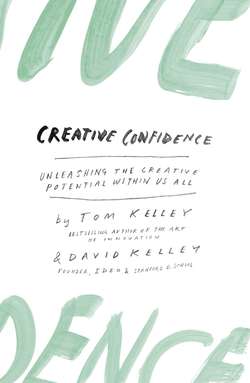Читать книгу Creative Confidence: Unleashing the Creative Potential Within Us All - David Kelley - Страница 15
INNOVATING ROUTINELY WITH DESIGN THINKING
ОглавлениеDesign thinking is a way of finding human needs and creating new solutions using the tools and mindsets of design practitioners. When we use the term “design” alone, most people ask what we think about their curtains or where we bought our glasses. But a “design thinking” approach means more than just paying attention to aesthetics or developing physical products. Design thinking is a methodology. Using it, we can address a wide variety of personal, social, and business challenges in creative new ways.
Design thinking relies on the natural—and coachable—human ability to be intuitive, to recognize patterns, and to construct ideas that are emotionally meaningful as well as functional. We’re not suggesting that anyone base a career or run an organization solely on feeling, intuition, and inspiration. But an over-reliance on the rational and the analytical can be just as risky. If you have a problem that you can’t analyze easily, or that doesn’t have a metric or enough data to draw upon, design thinking may be able to help you move forward using empathy and prototyping. When you need to achieve a breakthrough innovation or make a creative leap, this methodology can help you dive into the problem and find new insights.
IDEO uses this kind of thinking to help organizations in the public and private sectors innovate and grow. We help clients envision what their new or existing operations might look like in the future—and build road maps for getting there. Beyond the product development work Tom described in The Art of Innovation, we now have the opportunity to create new companies and brands, working with clients all over the world to help them launch new products, services, spaces, and interactive experiences. While we continue to work on products from toys to ATM machines, these days we are just as likely to create a digital toolkit to help consumers sign up for health care insurance or design a better education system for the country of Peru. In the last several years, we have worked directly with clients to help them embed innovation into the fabric of their enterprises.
Both at IDEO and in our client organizations, we’ve found that design thinking helps to foster creative cultures and build the internal systems required to sustain innovation and launch new ventures.
BORN TO FLIP—THE BIRTH OF THE D.SCHOOL
In the early 2000s, David started experimenting with team teaching at Stanford with professors from other parts of the university (like Terry Winograd from Computer Science, Bob Sutton from Management Science and Engineering, and Jim Patell from the business school). Prior to that, David had taught only students in the design division at the School of Engineering who already identified themselves as creative. In these new interdisciplinary courses, however, he worked with MBAs and computer science students who often didn’t think of themselves that way.
It was in these classrooms that David and his colleagues could see what unlocking creativity really looked like.
Some of the students went beyond just using the tools and embraced the philosophy of design thinking, and in doing so, they developed a new mental outlook, a new self-image, and a new sense of empowerment. Students began visiting him during office hours—sometimes months after the class was over—to tell him that they had started to see themselves as creative individuals for the first time. That they could apply creativity to any challenge. Their eyes would light up with excitement, with a sense of opportunity, of possibility. Sometimes they cried.
David came up with a name for the transformation he was observing: “flipping”—changing from one state of mind to another. The playfulness of the term “flipping” reminded him of the joyful poetry of a somersault on a trampoline or a diving board.
These students he talked with were engaged and excited in a way that made it clear something in them had changed—permanently. It was the sort of profound impact educators live for.
Along with former student George Kembel (now executive director of the d.school), David began to talk with friends and colleagues about starting a new program. He envisioned a place in the university where students from different backgrounds could come to nurture their creative talents and apply their newfound skills to tough challenges. David pointed out that Stanford—like all world-class universities—had Nobel-laureate-quality researchers drilling deeper into their own fields of knowledge. But he suggested that there are tremendous challenges in the twenty-first century that aren’t going to be solved that way. Maybe some solutions will be found by putting that scientist into a room with a businessperson, and a lawyer, and an engineer, and others. Rather than keeping all their eggs in the “going deep” basket, David proposed that Stanford make at least a small side bet on “going broad.” And one day the new institute might have the respect and the cachet of the graduate school of business—commonly known as the “B-school.” That’s how the new venture got its nickname, which has stuck ever since: the “d.school.”
When he told Hasso Plattner, one of the founders of enterprise software giant SAP, about the idea, Hasso generously reached for his checkbook. The d.school—officially known as the Hasso Plattner Institute of Design—opened its doors in 2005.
